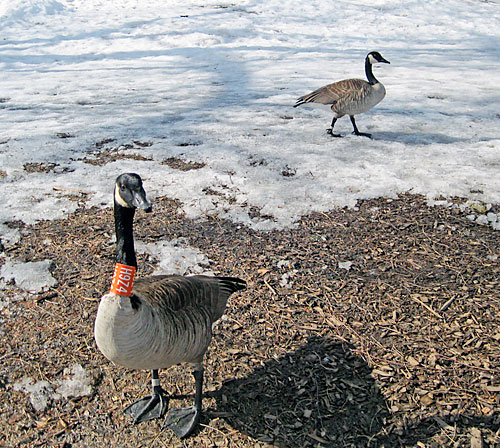Meet Prospect Park’s celebrity couple du jour — two geese with tags on their legs and targets on their heads.
The feathered squawkers flew all the way from Quebec to perch next to the park’s glistening lake — but their arrival only draws more attention to the likelihood that the duo and their new friends will be dead later this summer.
Roughly 162 geese now call the park home — up from zero after federal officials slaughtered about 250 in July — and as that number swells, wildlife advocates are getting nervous.
There is no precise “goose count” that would prompt another killing by the federal Department of Agriculture, said agency spokeswoman Carol Bannerman, but higher populations mean a greater threat to aviation.
“It isn’t the answer people want to hear — but when there are hundreds of birds, the risk [to airplanes] is higher,” she said.
In 2009, the agency exterminated waterfowl within a five-mile radius of both LaGuardia and JFK airports — a measure that was expanded to Prospect Park without public discussion last year and culminated in the July massacre.
Nonetheless, the number of geese has steadily increased, evidence that the slaughter was not necessary.
“You can’t get rid of them,” said Anne-Katrin Titze, a wildlife rehabilitator and waterfowl advocate. “It shows the futility of what happened last summer.”
One of the gregarious little squawkers — who is named Pierre and flew from Boucherville, Quebec — arrived solo on Jan. 28, sporting a peculiar orange necklace that reads “H9Z4.”
The other, an aloof female with a May birthday, appeared a few days later, wearing an anklet that reads, “1048-75724.” Park-lovers initially named the lady goose Jacques, until her sex was revealed, and she was renamed Jacqueline.
Both geese were tagged with silver web bands by researchers at the University of Quebec to track their survival in man-made habitat.
Bannerman said the banding is not linked to the Department of Agriculture’s efforts to control the population of wild geese in Prospect Park, and that there are no plans — yet — to gas them like last year.
But the swelling population, coupled with Bannerman’s suggestion that higher numbers of geese are a concern for aviation, prompted concern among the geese’s advocates.
And more geese are likely on the way. Man-made areas like Prospect Park are normally a perfect place for Canada geese, said Jean-Francois Giroux, a University of Quebec professor in charge of tracking Jacqueline, Pierre and the other 300 or so banded birds in his flock. “[They] can escape predators and graze in well-maintained grass.”
Giroux was, of course, speaking about natural predators, not humans.
After the outcry over last year’s killings, federal officials have discussed recommendations to control goose population in the park, although “no specifics” about the effort are available, Bannerman said.





















